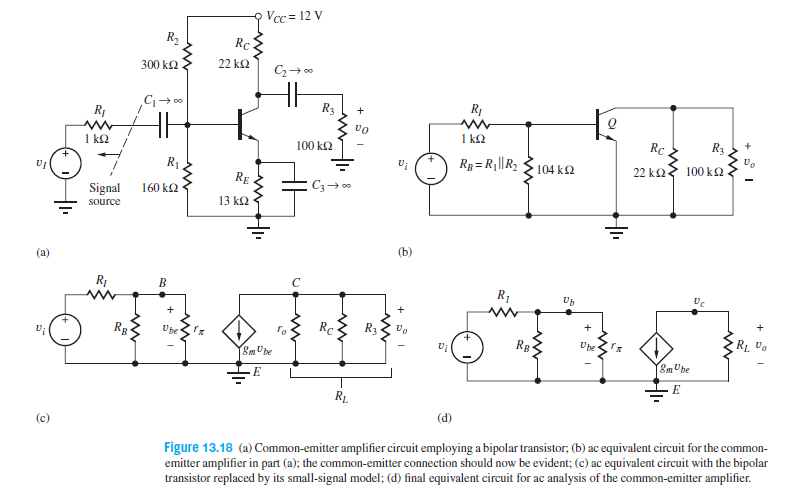Vcc = 12 V R2 Rc 300 k2 22 k2 R3 R1 RỊ vo 1 k2 Rc R3, 1 k2 100 k2 Rg = R||R2 22 k2 R1. 104 k2 100 kQ RE C3→0 Signal 160 k2 13 k. source (b) (a) R1 R; Rg Rc Ra Ube RB Ube RL Vo T&mUbe 8m Ube RL (d) Figure 13.18 (a) Common-emitter amplifier circuit employing a bipolar transistor; (b) ac equivalent circuit for the common- emitter amplifier in part (a); the common-emitter connection should now be evident; (c) ac equivalent circuit with the bipolar transistor replaced by its small-signal model; (d) final equivalent circuit for ac analysis of the common-emitter amplifier.
Vcc = 12 V R2 Rc 300 k2 22 k2 R3 R1 RỊ vo 1 k2 Rc R3, 1 k2 100 k2 Rg = R||R2 22 k2 R1. 104 k2 100 kQ RE C3→0 Signal 160 k2 13 k. source (b) (a) R1 R; Rg Rc Ra Ube RB Ube RL Vo T&mUbe 8m Ube RL (d) Figure 13.18 (a) Common-emitter amplifier circuit employing a bipolar transistor; (b) ac equivalent circuit for the common- emitter amplifier in part (a); the common-emitter connection should now be evident; (c) ac equivalent circuit with the bipolar transistor replaced by its small-signal model; (d) final equivalent circuit for ac analysis of the common-emitter amplifier.
Introductory Circuit Analysis (13th Edition)
13th Edition
ISBN:9780133923605
Author:Robert L. Boylestad
Publisher:Robert L. Boylestad
Chapter1: Introduction
Section: Chapter Questions
Problem 1P: Visit your local library (at school or home) and describe the extent to which it provides literature...
Related questions
Question
A common-emitter amplifier similar to as shown is operating from a single +20-V power supply, and the emitter terminal is bypassed by capacitor C3. The BJT has βF =100 and VA=50 V and is operating at a Q-point of (100 μA, 10 V). The amplifier has RI = 5 kΩ, RB = 150 kΩ, RC = 100 kΩ, and R3 = ∞. What is the voltage gain predicted from our rule of thumb estimate? What is the actual voltage gain? What is the value of μf for this transistor?

Transcribed Image Text:Vcc = 12 V
R2
Rc
300 k2
22 k2
R3
R1
RỊ
vo
1 k2
Rc
R3,
1 k2
100 k2
Rg = R||R2
22 k2
R1.
104 k2
100 kQ
RE
C3→0
Signal
160 k2
13 k.
source
(b)
(a)
R1
R;
Rg
Rc
Ra
Ube
RB
Ube
RL Vo
T&mUbe
8m Ube
RL
(d)
Figure 13.18 (a) Common-emitter amplifier circuit employing a bipolar transistor; (b) ac equivalent circuit for the common-
emitter amplifier in part (a); the common-emitter connection should now be evident; (c) ac equivalent circuit with the bipolar
transistor replaced by its small-signal model; (d) final equivalent circuit for ac analysis of the common-emitter amplifier.
Expert Solution
This question has been solved!
Explore an expertly crafted, step-by-step solution for a thorough understanding of key concepts.
Step by step
Solved in 4 steps with 7 images

Knowledge Booster
Learn more about
Need a deep-dive on the concept behind this application? Look no further. Learn more about this topic, electrical-engineering and related others by exploring similar questions and additional content below.Recommended textbooks for you

Introductory Circuit Analysis (13th Edition)
Electrical Engineering
ISBN:
9780133923605
Author:
Robert L. Boylestad
Publisher:
PEARSON

Delmar's Standard Textbook Of Electricity
Electrical Engineering
ISBN:
9781337900348
Author:
Stephen L. Herman
Publisher:
Cengage Learning

Programmable Logic Controllers
Electrical Engineering
ISBN:
9780073373843
Author:
Frank D. Petruzella
Publisher:
McGraw-Hill Education

Introductory Circuit Analysis (13th Edition)
Electrical Engineering
ISBN:
9780133923605
Author:
Robert L. Boylestad
Publisher:
PEARSON

Delmar's Standard Textbook Of Electricity
Electrical Engineering
ISBN:
9781337900348
Author:
Stephen L. Herman
Publisher:
Cengage Learning

Programmable Logic Controllers
Electrical Engineering
ISBN:
9780073373843
Author:
Frank D. Petruzella
Publisher:
McGraw-Hill Education

Fundamentals of Electric Circuits
Electrical Engineering
ISBN:
9780078028229
Author:
Charles K Alexander, Matthew Sadiku
Publisher:
McGraw-Hill Education

Electric Circuits. (11th Edition)
Electrical Engineering
ISBN:
9780134746968
Author:
James W. Nilsson, Susan Riedel
Publisher:
PEARSON

Engineering Electromagnetics
Electrical Engineering
ISBN:
9780078028151
Author:
Hayt, William H. (william Hart), Jr, BUCK, John A.
Publisher:
Mcgraw-hill Education,